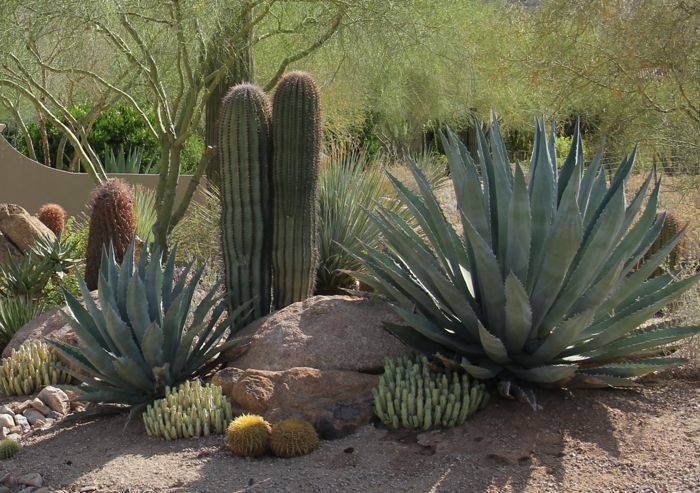If you are new to Scottsdale, here are 10 tips to help adapt your landscaping practices. Having a beautiful and low maintenance yard is simple when you follow these steps. The when, where and how of gardening in Scottsdale is different from other parts of the country, yet easy to learn.
1. Planting time: Fall is our Spring
Here in Scottsdale, fall is the best time to plant.
Why? Following summer, fall soils hold heat, promoting root growth. Furthermore, consistent temperatures settle in during October and November and plants are not generally exposed to extreme heat or cold.
After planting in fall, when spring arrives, roots are established and flourish in higher temperatures. The following summer, plants have strong roots to weather heat.
Exceptions: Frost sensitive plants (e.g. hibiscus, bougainvillea, citrus) should be planted late spring and require water all summer to establish roots.
2. Adapting to desert soil
Desert soils are mostly sand and clay. They are alkaline, not acidic which means lime is not added. Our soil contains little organic matter, so compost should be added to beds containing plants with shallow roots (e.g. flowering annuals, vegetables). Add ground bark or compost to help nutrients and water adhere to roots.

Drainage in caliche soil. (Source: U of A agricultural school)
Take note: Scottsdale soils may have caliche. Caliche is a layer containing particles ‘cemented’ together by lime (calcium carbonate, CaCO3). Caliche looks like concrete. Layers vary in thickness and there may be more than one layer.
Caliche can be easily managed. Keep plant roots out of caliche, remove caliche and replace it with a soil mix, or dig through the caliche to provide water drainage.
3. So many plants, so little time
Many plants are grown in Scottsdale; tropicals, cactus, succulents, native trees, shrubs, flowering perennials, plus plants grown in other climates. It’s tempting to give each a try in our gardens, and we often do.
Key to planting here is grouping plants by type and watering needs. Too many varieties of plants with dissimilar watering and exposure needs impact the proliferation and beauty of your garden.
Consider getting the advice of a professional landscape designer.
4. Lawn is a four-letter word
While “l-a-w-n” is a little less harsh than more colorful four letter words, this depiction draws awareness to the extra effort needed for lawn care in Scottsdale. Our average annual rainfall is 8 inches, not the 37 inches Chicago gets, nor the 17 inches Calgary gets. For people with kids, pets, or those who want a spot to walk barefoot, lawns have their place. Our advice is to minimize your lawn area in Scottsdale and opt for low-water ground covers. You’ll save on your water bill, and may qualify for a rebate from the city.
Synthetic lawns are a great alternative, today’s varieties are kid-friendly, pet-friendly and natural-looking.
5. Watering in the Summer
All plants that have weathered a summer or two need a deep water soaking every 2-3 weeks.
If you didn’t resist the urge and planted in spring, water the spring plantings 2-3 times a week in their first summer.
Always apply water around plants’ drip lines, where rainfall naturally drips from the plant to the ground.
Installing an irrigation system and timer will make your job easier, allowing control of how much water is applied where and how often.
6. Pruning
Many plants, especially flowering trees and shrubs, do best when pruned after flowers disappear. Yet, some winters are so mild plants are reluctant to cease growing or flowering. When pruning is needed, do it between December and March, but only when necessary. Avoid pruning early.
7. Mulch–it’s a good thing
Apply a 3″ layer of mulch over plant root zones; it reduces moisture loss, retards growth of weeds and cools upper layers of soil. Mulch can be inorganic, (e.g. rock or gravel); or organic, (e.g.compost, bark products). Mulch is inexpensive and helps plants grow better and use less water.
8. Respect the sun
Sunshine and heat can stress plants or kill them. This is particularly true of plants that thrived in your former climate, and not adapted to Scottsdale.
Select the hardiest of plants for southern and western exposures where there is intense sunlight and high temperatures.
The light and heat in eastern and northern exposure areas (including shade from trees)is kinder and better for more delicate species.
Likewise, respect the sun’s impact on you. Work outside early before it gets hot. Wear protective clothing, use sunscreen and drink water. Do heavy work in the milder temperatures of fall and winter.
9. Rain – Season Matters
Scottsdale has two rainy periods (albeit minimal): winter and summer.
Winter rains are steady, allowing moisture to soak into soil. Summer rains are usually intense storms (aka monsoon). They are localized, short, and capable of producing large quantities of water.
Don’t let excess rain fool you into cutting back on irrigation.The rain falling in summer can do more harm than good due to erosion from runoff. The benefit of a summer rainstorm is negligible; water doesn’t penetrate deep enough to get to roots.
10. Know homeowners’ association guidelines
To maintain the integrity of the desert, many Home Owners’ Associations (HOA) have guidelines on planting. Before starting, check with your HOA.
LOCAL AND ON-LINE RESOURCES
City of Scottsdale, List of Native Trees, Plants & Shrubs (/codes), Water Conservation & Rebates (/water), Landscape workshops (/water)
Landscape Watering Guide
http://wateruseitwisely.com/100-ways-to-conserve/landscape-watering-guide/
Artificial Grass: It’s not just for stadiums any more
http://online.wsj.com/news/articles/SB10001424127887324412604578517552670776878
CONTACT US for information on DC Ranch or Silverleaf homes for sale. We are DC Ranch real estate specialists.
Don Matheson
Realtor | Founder
The Matheson Team – RE/MAX Fine Properties
21000 N. Pima Rd., #100, Scottsdale, AZ 85255
480-360-0281
don@scottsdalerealestate.com








